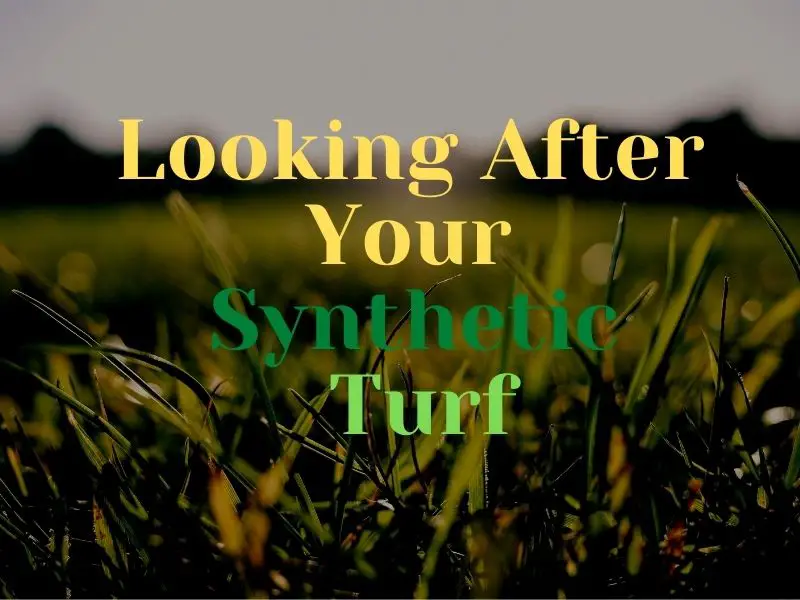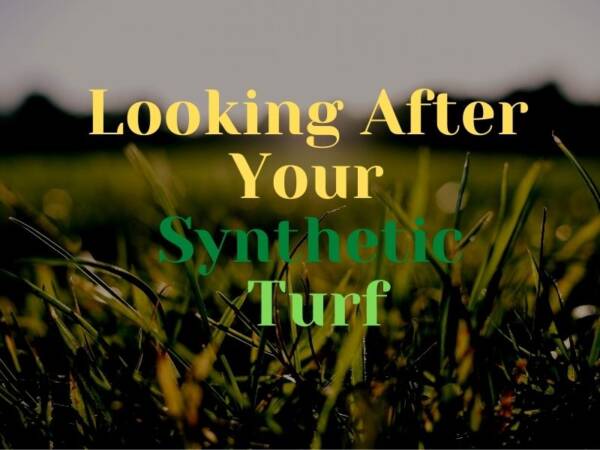
Looking After Artificial Grass

Synthetic turf or artificial grass is quickly becoming a popular choice for many homeowners and even commercial spaces. It’s an easy way to have a green lawn that requires little maintenance and looks lush all year.
There are also multiple benefits: artificial grass is low-maintenance, durable, natural-looking for entertaining, environmentally friendly, can withstand most weather all year, and can be used indoors or outdoors.
Quality artificial turf grass can be used for various applications, including landscaping, pets, sports, playgrounds, and golfing. However, like any type of surface that you use in your home or office, it needs proper maintenance to stay looking its best and last for years.
In this guide, we’ll discuss the basics of synthetic turf maintenance, including how often you should clean it and what tools to use when cleaning it up so that you can keep it looking beautiful all year long.
Equipment You’ll Need to Maintain Your Synthetic Turf
To routinely maintain your artificial grass, you’ll need a few essential tools. While you don’t need a lawnmower for synthetic turf, some of the most important equipment you need includes a leaf blower, a broom or rake with synthetic or plastic bristles, a lawn vacuum cleaner, and a water hose for basic maintenance.
A high-speed leaf blower is necessary to manage the leaves or debris that may land on your artificial grass.
You should also purchase a quality broom, brush, or rake made with synthetic or soft plastic bristles so as not to cause damage to your synthetic grass.
A vacuum cleaner with a strong but safe-to-use brush attachment is also necessary to remove dirt and debris from your synthetic turf fibers.
A water hose is needed to spray dirt off the surface of your synthetic turf and rinse the turf.
A steam mop can be used for deep cleaning and maintaining a soft texture.
If you have pets, consider getting an animal-repellent spray for your artificial grass. This can help keep pet hair and other dirt from accumulating on the synthetic turf blades as much.
You may also want to purchase a cover or matting to protect the surface of your artificial lawn from damage caused by the sun’s rays if it is not in an area that receives much shade.
Keep the Synthetic Turf Clean and Free of Debris and Contaminants
Artificial turf is a great surface for outdoor play and recreation, but it can’t be left in this condition indefinitely. One of the most important aspects of maintaining your synthetic turf involves keeping it clean.
The number one rule for cleaning artificial grass is never to use water with detergent on the blades – as both will damage them. Instead, you can use a broom, leaf blower, or vacuum cleaner to remove the debris and contaminants from your turf.
- If you’re going to use water to rinse off the dirt from your turf surface, it should only be done using plain water and a hose.
- Ensure that the turf is completely dry before you resume any activity on it.
- Avoid walking or playing directly on wet blades of grass, which will lead to debris accumulating quickly.
- If your artificial turf has a finish, such as a rubber infill, sand granules, or polyethylene beads, you must pay special attention to maintaining the surface.
Groom the Surface Regularly to Preserve the Appearance (Brush)
To ensure that your synthetic turf looks its best, groom it regularly. This means brushing the surface with a hand brush to remove loose dirt and debris, which makes the artificial grass look dull.
Grooming the turf will preserve its appearance and keep it looking fresh. The type of brush you use matters, so be sure to use a soft brush, which will not damage the blades. As mentioned above, investing in a leaf blower or vacuum cleaner with an attachment that will allow you to effectively deep clean the surface and edges is highly recommended.
- The frequency of grooming your artificial grass will depend on various factors, including sun exposure (likely daily), foot traffic (weekly), and what type of artificial grass you have.
- You might only need to groom your turf once every two weeks, but this will depend on how often these factors come into play.
- Grooming should be done anytime the blades are dirty, which happens when they accumulate dust from the surface beneath them.
Remote Pest Waste as Soon as Possible to Avoid Foul Smells
Foul smells are a common complaint of synthetic turf owners. The culprit is often pet waste, which should be removed as soon as it becomes visible to reduce the risk of odor problems.
Pet waste can come from your dog (s), cat (s), or any nearby animals that use your artificial lawn in your backyard lawn or garden, including rats, skunks, and raccoons. They usually leave droppings and urine that humans can smell. But the most common type of pet waste is dog feces, which should be picked up daily and disposed of in the garbage or trash bin (not down your drain).
- You may find it beneficial to purchase a pooper scooper from any pet store if you cannot pick up the waste daily.
- Go through your artificial grass yard and garden and remove any animal droppings or urine as quickly as possible.
- When there’s poop on synthetic turf, wait for it to dry out, and then remove it with a stiff piece of cardboard or plastic.
- If it has already dried out on the artificial grass blades, you can use a garden hose to spray away any remaining waste.
Learn How to Remove Stains to Keep Your Turf Looking Beautiful
What can you do to keep your turf looking beautiful? One way is to learn how to remove stains from it. You should know what the most common types of stains are and how best to address them.
The most common types of stains are caused by dirt and food/beverage spills. If you have kids and pets constantly playing on your synthetic turf, then you know how hard it can be to keep stains from showing up. You’ll need to follow specific steps when handling different strains.
- For Mild Stains – The life of a homeowner is an unpredictable adventure. Often in your backyard or when hosting guests, things go wrong, and you will need to address many spills: alcohol, cola, coffee, food, tea, and other simple everyday substances.
- To remove these mild stains, you can use a solution of dish soap and water. Apply the mixture to the stain using a soft cloth or sponge, then gently scrub it into the turf until you see it lift off the surface.
Artificial Grass – Keep these tips in mind
- Act quickly if you want to stop a spill from leaving an unwanted, stubborn stain
- Dab up spilled liquid with a towel or dry material, like kitty litter
- Soak and rinse the area in a mixture of water and mild detergent. It will not harm the synthetic fibers.
- To make your stain removal solution work even better, you can add about 3% ammonia to the water.
- Rinse the cleaner out using clean, cool water
- For Moderate Stains – Use your garden hose with a spray nozzle to a “stream” setting. Spray from about six inches away in short bursts, then use a brush or your hand to scrub the area.
Artificial Grass – Keep these tips in mind
- If you have an oily stain, try using a cleaner that is specially planned for oil stains.
- Apply it generously and let it sit on the surface for at least 20 minutes before wiping it away with a cloth soaked in clean water
- Rinse thoroughly afterward
- If you have a light color turf, use an alkaline soap solution
- For Stubborn Stains – Substances like motor oil, grease, pen, ink, cooking oil, suntan lotion, and crayons are often more stubborn to remove than conventional stains. If you’re trying some household detergent or ammonia mixture and it doesn’t work – take a deep breath because what you need next is mineral spirits.
- Use a solution of 50% water and 50% mineral spirits
- Stir until the mixture is free of lumps, then apply liberally to the stain with a sponge or scrub brush
- Let it soak for 20 minutes before removing it with cloths soaked in clean water
- Rinse thoroughly afterward
- For the Sticky Stuff – Tree sap, chewing gum, and other items can lead to artificial turf maintenance problems. Fortunately, there are some relatively simple ways of removing them, which you should know before it becomes an issue. You can use dry ice or aerosol refrigerants to freeze the sap or gum and scrape it off the grass.
Check and Maintain Proper Infill Levels for a Consistent Surface
Another key maintenance task is ensuring that your infill levels are consistent. You should check the infill levels and top them off as needed. This allows the turf fibers to hold their shape better and the infill to be spread more uniformly.
Neglecting infill levels will cause a bumpy surface, which can lead to injuries. Ensuring proper infill levels is critical for commercial synthetic turf surfaces like golf greens and sports fields.
Inspect Your Turf and Perform Minor Repairs to Avoid Playing Hazards
You should also inspect your turf and perform minor repairs to avoid playing hazards. If you see steaming nails sticking up, fix them with a nail punch or hammer.
Fix divots by filling in the holes with sand and tamping it down firmly. Over time, you may experience some minor damage to your turf that needs to be fixed.
- For example, you might need to replace an infill layer if it’s too thin or becomes compacted.
- If you notice loose seams in the backing of your artificial grass where chunks are peeling off and sticking up, use a screwdriver or other long-handled tool with a flat blade to nuzzle the pieces back into place.
- For large patches of missing turf, you can use a utility knife and scissors to cut off any loose edges from an approved piece and glue it in with contact cement or other adhesive if desired.
- For damaged turf, consider replacing it with a similar product to create continuity.
Maintain Your Synthetic Turf for the Long Term
The best way to keep your synthetic turf looking like new is with routine maintenance. This includes regular vacuuming, brushing (with a soft-bristled brush), and frequent power washing.
This way, you can remove dirt, debris, and leaves as soon as they hit the turf. You’ve invested in an evergreen lawn that you can use all year, so take some time to take care of it to enjoy it for years to come.
Surf
